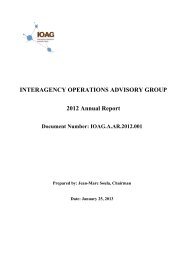OLSG Report_Final_06_05_12 - Interagency Operations Advisory ...
OLSG Report_Final_06_05_12 - Interagency Operations Advisory ...
OLSG Report_Final_06_05_12 - Interagency Operations Advisory ...
Create successful ePaper yourself
Turn your PDF publications into a flip-book with our unique Google optimized e-Paper software.
3.2 Highly Elliptical Earth Orbit (HEO) Scenario<br />
Optical Link Study Group (<strong>OLSG</strong>) <strong>Final</strong> <strong>Report</strong><br />
IOAG.T.<strong>OLSG</strong>.20<strong>12</strong>.V1<br />
The HEO Scenario is not elaborated as it is considered similar to the Lunar Scenario with<br />
shorter distances.<br />
3.3 Geostationary Earth Orbit (GEO) Scenario<br />
This scenario is discussed in section 4.1.1.2.3 Earth Relay Optical Feeder Link and section 4.2<br />
Telecom Mission Optical Feeder Uplink.<br />
3.4 Lunar Scenario<br />
3.4.1 Concept of <strong>Operations</strong><br />
3.4.1.1 Basic Concept of <strong>Operations</strong><br />
The Lunar Scenario refers to a system providing optical communications from a lunar<br />
orbiting satellite to a ground station on the Earth’s surface. This scenario is of particular<br />
interest since the NASA LLCD is currently in preparation for a 2013 launch. Much of this<br />
scenario description is drawn from LLCD experience, as well as extrapolation to potential<br />
future lunar missions. The space terminal of LLCD is called the Lunar Lasercomm Space<br />
Terminal (LLST) and the dedicated ground terminal is called the Lunar Lasercomm Ground<br />
Terminal (LLGT).<br />
The first criterion for a free space optical link is geometric line of site from the spacecraft to<br />
a ground terminal. As with other scenarios, the optical link quality is affected by the ground<br />
station elevation angle, with lower elevations reducing the link capabilities. For all lunar<br />
orbiting spacecraft, the first obvious requirement is line of sight to the Moon itself; thus,<br />
lunar elevation angles will be consistent for all missions in this scenario analysis. Orbitspecific<br />
information further refines the scenario, though this information will vary from<br />
mission to mission.<br />
LLCD will be launched on LADEE. This science mission will fly a relatively low altitude (250<br />
km) retrograde lunar orbit. Due to the specific orbit, the satellite regularly passes behind<br />
the Moon and loses contact with the ground station. For LADEE, the passes with geometric<br />
line of sight vary between 40 and 80 minutes in duration. Lunar polar orbits that do not<br />
pass behind the Moon (from perspective of the ground site) would have more continuous<br />
geometric access when the Moon is in the sky.<br />
Under current plans, LLCD will be able to communicate with two ground stations. One—the<br />
LLGT—is a transportable terminal currently slated to be located on Mount Haleakala, on<br />
Maui, Hawaii. The second ground site is the OCTL, located on Table Mountain, California;<br />
this site is referred to as the Lunar Lasercomm OCTL Terminal (LLOT).<br />
The geometry from LADEE to the two ground sites illustrates several general features of<br />
lunar missions. These features are particularly relevant for interoperability, as multiple<br />
ground sites would be a major benefit of interoperability. While California and Hawaii are<br />
not at the same longitude, the fact that they are in the same hemisphere means that the<br />
Moon is visible simultaneously to both sites much of the time. Consider Figure 29, which<br />
shows the access times to the LLST from the two ground sites over a one-month period<br />
beginning July 1, 2013. Access is plotted at the given elevation angle. From the figure, one<br />
Page | 61



